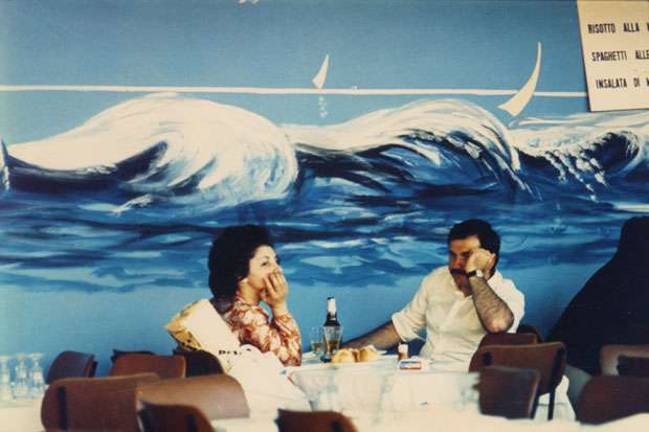Blink First

Luigi Ghirri's photographs give new perspective
A few of the images in Luigi Ghirri's "Kodachrome" series (on view now at the Matthew Marks gallery) are unexpectedly religious. A wooden bench with a soft, curved back sits on a pink and white tiled floor in an old hotel. An arched brick doorway reveals a folded beach chair, its cloth cover bleached by the sun (Marina de Ravenna). The spaces are narrow, worn, and peaceful, like church pews.
Ghirri is very, very good at changing the way that we see. His photos can seem almost too gentle, but they have a way of making you blink.
For one thing, the photos don't bother with perspective. Instead, they flatten out space, almost like pre-Renaissance painting. Objects either exist in isolation (like the beach chair and the bench) or stand side by side as equals.
Ghirri loves to jam two different scenes together, pulling everything out of its context. In Engelberg tourists stand in front of a gigantic Sprite ad showing snowy mountains and waterfalls and the Sprite logo. The tourists look like they've been plunked down in some imaginary Switzerland; they're helpless and a little bit lost. And of course, the ad isn't just an ad anymore. It's real scenery now, taking over the world.
Bologna uses the same technique. A couple sits in a restaurant, heads on their hands, waiting for dinner. But they're in front of a roaring ocean scene, a mural that fills all the space in the shot. How can they be bored, in front of such an ocean? How can we all let so much of life pass us by? Like Engleberg, Bologna is almost laughably easy on the eyes, but it's uncomfortably stirring.
Some of Ghirri's work loses its way and falls into shallow whimsy. Modena is a photograph of two paintings, side by side. One shows bare, wintry trees, and the other is all houses and mountains. The frames touch, but the images never can. It's clever, it's interesting, but in the end it doesn't say much.
Cluny is similarly facile. It's a picture of a picture: Ghirri has hung a picture of an imposing French medieval cathedral on a monastery wall. The church in the picture is in perfect condition but the wall it's hanging on is crumbling, ancient. Which is the real image, which is the real truth? Cluny wont tell you, but Ghirri's better photographs will hint at an answer.
Luigi Ghirri: "Kodachrome" will be on display at the Matthew Marks gallery (526 w 22nd street) through April 20